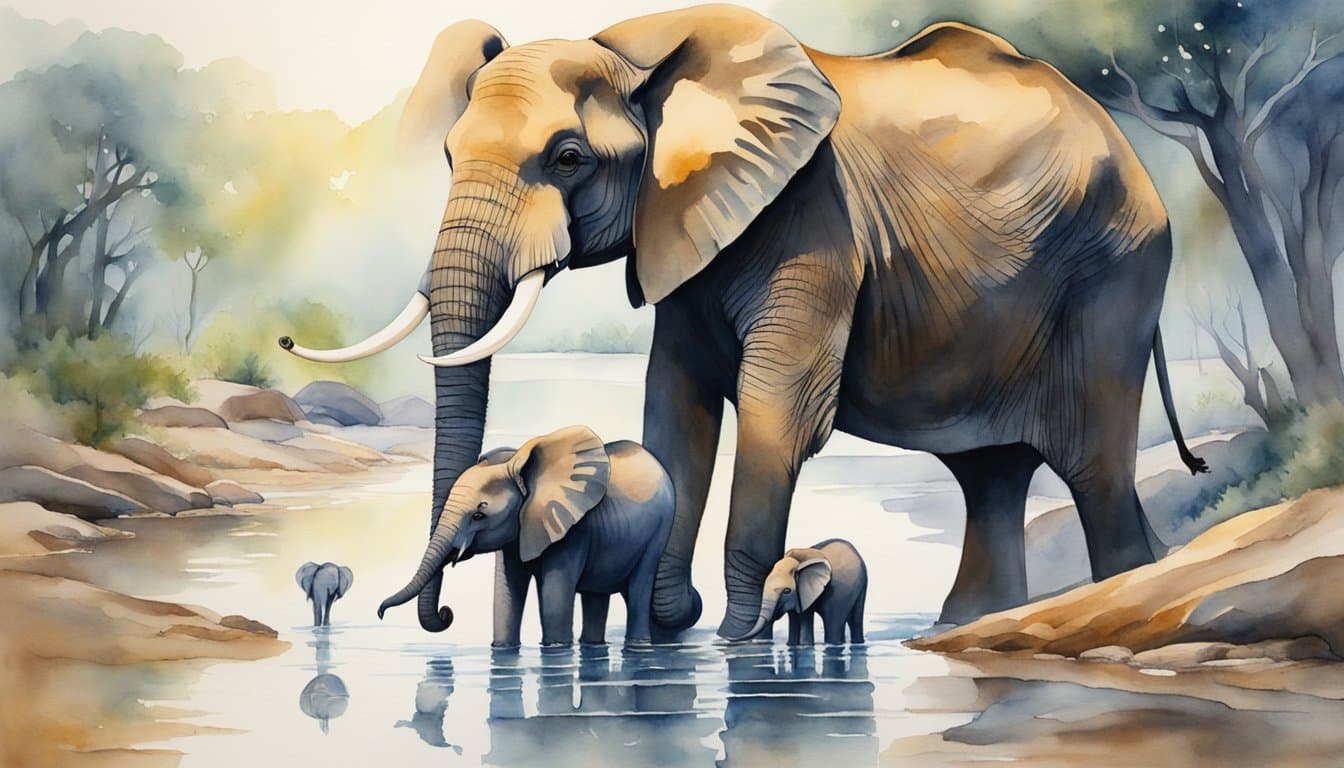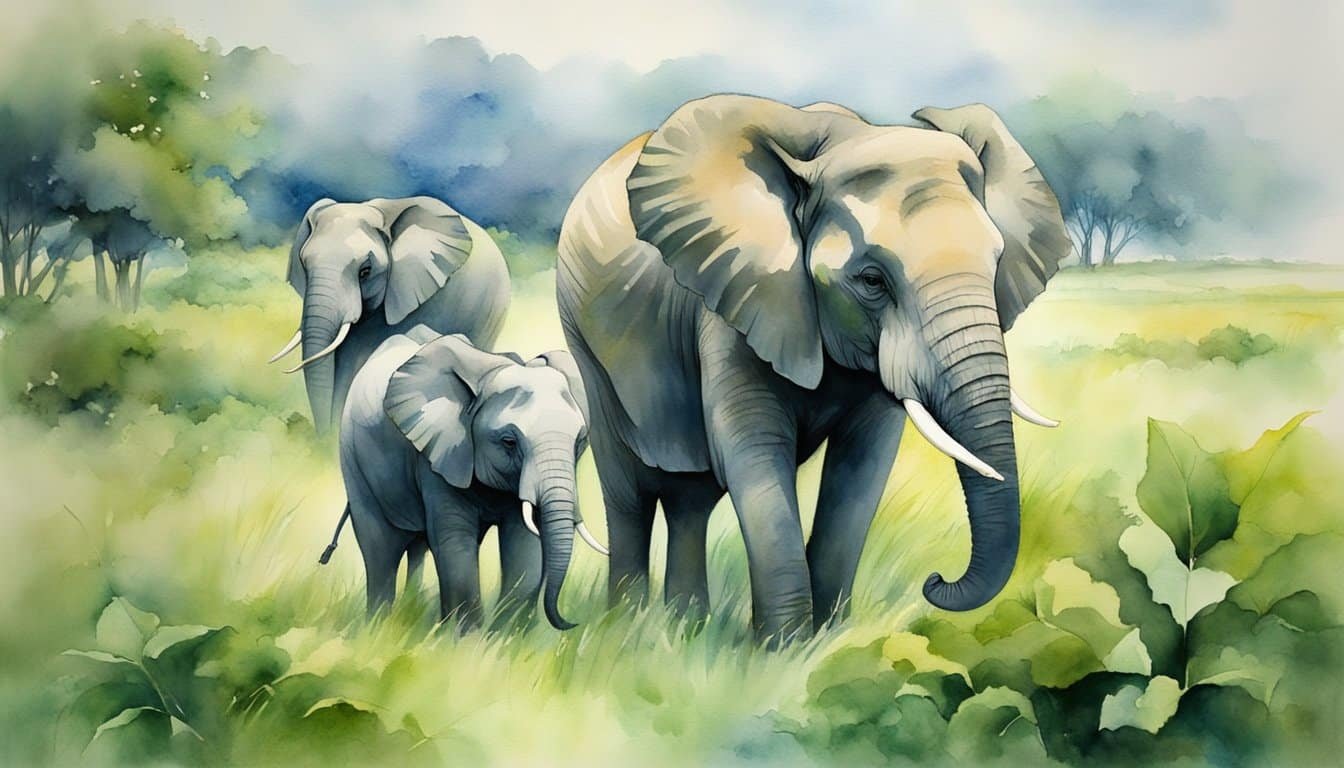Elephants are famed for their impressive memory, a trait that is pivotal for their survival in the wild.
This section delves into the mechanisms and significance of memory in elephants, covering various aspects from their developmental stages to the roles memory plays in their complex social structures.
Memory Development in Elephants
From a young age, elephants exhibit remarkable memory abilities.
As calves grow, they learn and remember the vast networks of their habitat, essential for locating food and water sources.
This knowledge is passed down through generations, thanks to the matriarch’s rich memory of the landscape.
Elephant Brain and Encephalization Quotient
The encephalization quotient (EQ) is a measure of brain size relative to body size, and elephants have a high EQ, indicative of their advanced cognitive functions.
Their large brains facilitate a vast storage of memories, vital for their survival.
Cognitive Abilities and Self-Awareness
Elephants have displayed the ability to recognize themselves in a mirror, which is a testament to their self-awareness.
They employ intricate problem-solving skills and utilize tools, showcasing a sophisticated degree of elephant cognition not commonly seen in the animal kingdom.
Social Bonds and Communication
Social life amongst elephants relies heavily on memory.
They remember and grieve lost family members, maintaining deep social bonds.
Communication is complex and includes a combination of vocalizations and body language, helping them to convey not only information but also emotions and social relationships.
Elephants in the Wild Vs Captivity

The lives of elephants in the wild and captivity differ greatly across various aspects such as their survival tactics, leadership dynamics, and interaction with humans and other species.
These differences have profound effects on their memory, social structure, and overall health.
Survival Tactics and Clan Dynamics
In the wild, elephants form close-knit clans that are vital for their survival.
The clans, led by experienced matriarchs, remember the routes to water holes especially during times of drought, a testament to their remarkable long-term olfactory memory.
Matriarchs’ memories often become the difference between life and death for their groups in the changing climate.
These clans also adopt defensive formations to protect their young from poachers and predators, indicating not only memory but strategic intelligence.
Matriarchs and Group Leadership
Elephant herds are shaped by their matriarchs, the eldest and often most experienced females who lead the group.
Their roles in the wild are crucial as they recall crucial information like the location of food sources during different seasons and have the wisdom to navigate social complexities within and outside their clans.
Captive elephants may not have the same intricate group leadership or necessity for these strong memory traits for survival, yet they still exhibit signs of complex social behaviors.
Interactions with Humans and Other Animals
Wild elephants encounter various species including potential dangers such as humans and lions, whereas interactions for captive elephants are predominantly with humans, often leading to diverse effects on elephant behavior and intelligence.
In some regions, elephants have been known to hold grudges against specific human communities, such as the Maasai tribe, due to past conflicts.
This complex relationship showcases their impressive memory and highlights how different experiences with humans can shape elephant intelligence and reactions in diverse environments.
Elephant Memory in Culture and Conservation

They say an elephant never forgets, and this remarkable memory has made elephants emblematic in various forms of art and entertainment.
From paintings that depict scenes of these majestic creatures to the popular narratives that revolve around their wisdom, creativity has flourished around elephant lore.
Notably, elephants in the circus have showcased not only their memory but also their ability to play and engage with humans, albeit not without controversy.
Conservation Efforts and Human Impact
As symbols of the animal kingdom, elephants’ knack for remembering experiences has a somber side: it implies a deep awareness of the threat they face from poaching.
Organizations like the World Wildlife Fund use their knowledge of elephant memory and intelligence to promote anti-poaching measures.
Meanwhile, identification studies in places like Amboseli National Park are central to conservation strategies, helping track family groups and maintain genetic diversity.
Research and Understanding of Elephant Memory
The depth of elephant cognition is a topic of fascination in science journalism, shedding light on elephant intelligence comparable to apes and dolphins.
Researchers like Richard Byrne from the University of Saint Andrews explore how elephants use tools and memory to navigate their environments.
At the University of Sussex, studies delve into how these memories influence elephant social interactions and decisions, demonstrating a complex level of animal intelligence that is crucial for their survival.




